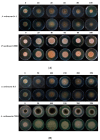The Influence of NaCl and Glucose Content on Growth and Ochratoxin A Production by Aspergillus ochraceus, Aspergillus carbonarius and Penicillium nordicum
- PMID: 32806492
- PMCID: PMC7472267
- DOI: 10.3390/toxins12080515
The Influence of NaCl and Glucose Content on Growth and Ochratoxin A Production by Aspergillus ochraceus, Aspergillus carbonarius and Penicillium nordicum
Abstract
Ochratoxin A (OTA) is a nephrotoxic mycotoxin, which deserves particular attention for its widespread contamination of a variety of food and feed. Aspergillus ochraceus, Aspergillus carbonarius, and Penicillium nordicum are an important source of OTA in three different kinds of food commodities, including cereals, grape and dried fruit products, and dry-cured meat products. Deeper knowledge of OTA production and mycelium growth related to the high-sugar or NaCl-rich environments was gained in this manuscript. A. ochraceus and P. nordicum were likely to have greater growth rates in medium supplied with certain concentrations of NaCl (0-80 g/L), and the colony diameter was the largest at the salt content of 40 g/L. P. nordicum was more suitable to grow in NaCl-riched medium, the OTA production was increased to 316 ppb from 77 ppb when 20 g/L NaCl was added. The capability of OTA production was inhibited when salt content was 40 g/L and 60 g/L in A. ochraceus and P. nordicum, respectively. As the glucose content increased to 250 g/L, the capacity of mycelium growth and sporulation was increased significantly in A. ochraceus and A. carbonarius. A. carbonarius was more suitable to grow in high-sugar grape products. OTA production was significantly promoted with an added 100 g/L glucose in A. carbonarius. OTA production was inhibited when glucose content was 150 g/L and in 200 g/L in A. ochraceus and A. carbonarius, respectively. NaCl and glucose have an effect on fungal growth and OTA production, and the activation of biosynthetic genes of OtaA. These results would allow designing new strategies to prevent OTA accumulation on sugar or NaCl-riched foodstuffs and achieve the objective to manufacture cereals, dried vine fruits and dry-cured ham, free of OTA.
Keywords: A. carbonarius; A. ochraceus; NaCl-riched; P. nordicum; high-sugar; ochratoxin A.
Conflict of interest statement
The authors declare no competing financial interest.
Figures







Similar articles
-
Influence of ochratoxin A on adaptation of Penicillium nordicum on a NaCl-rich dry-cured ham-based medium.Int J Food Microbiol. 2018 May 2;272:22-28. doi: 10.1016/j.ijfoodmicro.2018.02.020. Epub 2018 Feb 21. Int J Food Microbiol. 2018. PMID: 29505956
-
A Consensus Ochratoxin A Biosynthetic Pathway: Insights from the Genome Sequence of Aspergillus ochraceus and a Comparative Genomic Analysis.Appl Environ Microbiol. 2018 Sep 17;84(19):e01009-18. doi: 10.1128/AEM.01009-18. Print 2018 Oct 1. Appl Environ Microbiol. 2018. PMID: 30054361 Free PMC article.
-
Differences in the regulation of ochratoxin A by the HOG pathway in Penicillium and Aspergillus in response to high osmolar environments.Toxins (Basel). 2013 Jul 19;5(7):1282-98. doi: 10.3390/toxins5071282. Toxins (Basel). 2013. PMID: 23877195 Free PMC article.
-
Advances in the molecular diagnosis of ochratoxin A-producing fungi.Food Addit Contam. 2005 Apr;22(4):324-34. doi: 10.1080/02652030500058452. Food Addit Contam. 2005. PMID: 16019802 Review.
-
Ecophysiology of ochratoxigenic Aspergillus ochraceus and Penicillium verrucosum isolates. Predictive models for fungal spoilage prevention - a review.Food Addit Contam. 2006 Apr;23(4):398-410. doi: 10.1080/02652030500376102. Food Addit Contam. 2006. PMID: 16546886 Review.
Cited by
-
Modulation of Virulence-Associated Traits in Aspergillus fumigatus by BET Inhibitor JQ1.Microorganisms. 2022 Nov 18;10(11):2292. doi: 10.3390/microorganisms10112292. Microorganisms. 2022. PMID: 36422362 Free PMC article.
-
Characterization and biocontrol potential of Wickerhamomyces subpelliculosus yeasts isolated from dates: Volatile compounds-mediated antifungal activity against mycotoxigenic Penicillium strains.Heliyon. 2024 Oct 16;10(20):e39504. doi: 10.1016/j.heliyon.2024.e39504. eCollection 2024 Oct 30. Heliyon. 2024. PMID: 39498023 Free PMC article.
-
Ochratoxin A in Dry-Cured Ham: OTA-Producing Fungi, Prevalence, Detection Methods, and Biocontrol Strategies-A Review.Toxins (Basel). 2022 Oct 9;14(10):693. doi: 10.3390/toxins14100693. Toxins (Basel). 2022. PMID: 36287962 Free PMC article. Review.
-
Screening and Optimization of Solid-State Fermentation for Esteya vermicola, an Entomopathogenic Fungus Against the Major Forest Pest Pine Wood Nematode.Microorganisms. 2025 Feb 17;13(2):434. doi: 10.3390/microorganisms13020434. Microorganisms. 2025. PMID: 40005800 Free PMC article.
-
Optimization of L-malic acid production from acetate with Aspergillus oryzae DSM 1863 using a pH-coupled feeding strategy.Microb Cell Fact. 2022 Nov 23;21(1):242. doi: 10.1186/s12934-022-01961-8. Microb Cell Fact. 2022. PMID: 36419102 Free PMC article.
References
-
- Zhao T., Shen X.L., Chen W., Liao X., Yang J., Wang Y., Zou Y., Fang C. Advances in research of nephrotoxicity and toxic antagonism of Ochratoxin A. Toxin Rev. 2017;36:39–44. doi: 10.1080/15569543.2016.1243560. - DOI
-
- Ramos A.J., Labernia N., Marín S., Sanchis V., Magan N. Effect of water activity and temperature on growth and ochratoxin production by three strains of Aspergillus ochraceus on a barley extract medium and on barley grains. Int. J. Food Microbiol. 1998;44:133–140. doi: 10.1016/S0168-1605(98)00131-7. - DOI - PubMed
Publication types
MeSH terms
Substances
Supplementary concepts
Grants and funding
LinkOut - more resources
Full Text Sources
Medical
Research Materials

